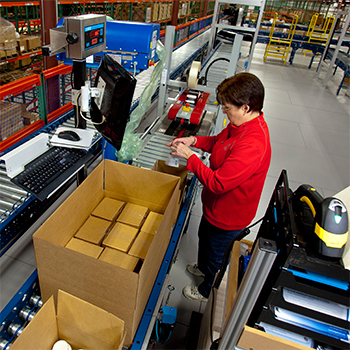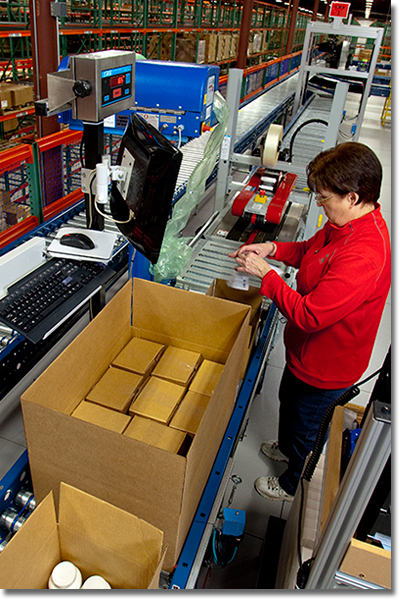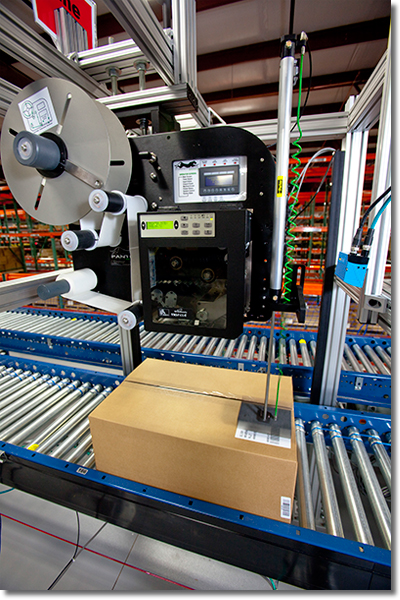Multi-channel order fulfillment, referred to in the logistics industry as omni-channel fulfillment, is increasingly becoming the norm for manufacturers, retail suppliers and retailers due to growing demand to fulfill a wide variety of order requirements ranging from single-line orders to full-trailer shipments. In order to satisfy the increasing variety of order sizes, operations need to be more efficient and flexible, and feature integrated pick, pack and ship order fulfillment processes with intelligent automation.
Omni-channel fulfillment is the ability to process orders within the same operation from multiple sales channels: internet/direct to consumer, specialty boutique stores, direct to big box retailers, and to other distributors. To provide this flexibility, an operation needs the right design, processes, and technologies to deliver what is now a critical business requirement. Continual growth in Internet fulfillment with instant mobile device order placement, and same-day customer shipment expectations, leads to distribution operations needing to pick, pack and ship in 2 to 4 hours or less, a fraction of the time compared to the current eight-hour shipment window norms.
Order fulfillment operations are struggling to find the proper balance of picking, packing and shipping technologies with best practices when implementing lean omni-channel fulfillment operations. Successful operations must process a mix of LTL (less than truckload) shipments with full-pallet/mixed-case-pallet orders, be able to fluid-load direct to the trailer, and balance the complexities compounded by the growing demand for combined split-case and mixed-case store and distribution center orders. Further complicating the order mix are retailers’ specific shipment compliance labeling and order shipment documentation requirements, and manifesting rules.
Now factor in the third element of the complex order mix: Internet fulfillment featuring seasonal spikes, and continuous order volume growth driven by new item releases, creates further challenges for defining and developing the processes and software requirements of a profitable operation. Thousands of orders per hour of single-item and multi-SKU orders, a wide variety of product cubes, and the customer-driven demand for the lowest cost transportation methods needed to ship direct-to-consumer orders, results in bottlenecks for traditional distribution operations.
Omni-channel order fulfillment requires a detailed plan and roadmap that considers all of the dynamics required to balance workloads and efficiently process orders in a parallel simultaneous pick and pack operation for each unique order fulfillment channel. Order release becomes the throttle of the operation and requires the right software algorithms to intelligently manage the order mix to meet customer type, delivery time windows, and ensure a continuous order flow to avoid bottlenecks and obtain optimum throughput across the pick, pack, and ship processes.
Related: Omni-Channel Supply Chains Designed for a Retail World without Boundaries
A proper order fulfillment design incorporates SKU slotting based on the mix of orders and material storage equipment/storage space. Picking needs speed, efficiency and accuracy to fill orders and coordinate and move labor to the work zones based on the current order wave volume. The design must be scalable to meet today’s need and still encompass the company’s five-year growth projections and business strategies. The design should be based on lean low-touch processes to lower current and future labor requirements, and incorporate proven processes enhanced by the latest automation technologies to lower implementation risk, improve accuracy and customer satisfaction, and drive higher operational profitability.
The challenge lies in meeting the above requirements within the typical two- to three-year ROI payback period for the typical corporation within the United States. The design requires a road map to include a thorough comparison of current processes with the new processes, and exception handling solutions focused on pinpointing major bottlenecks in the current DC operation. ROI should be shown on total cost of labor and ownership viewed within two-, three- and five-year windows.
Once the design is solidified, it should be modeled and simulated to ensure the new design is fully vetted prior to implementation. Only then can you objectively move to the selection of the right blend of automation technologies to enhance the processes and implement a lean, automated pick, pack, and ship order fulfillment operation.
What Best Orchestrates Omni-Channel Order Fulfillment?
A good design needs the right software to manage the order-fulfillment process. The question increasingly being asked is does current-generation enterprise resource planning (ERP) and warehouse management systems (WMS) provide the tools to perform the real-time execution and demands of an automated omni-channel fulfillment operation? Core strengths of an ERP and a WMS are managing receiving, inspection, inventory and replenishment within the warehouse or distribution center. The software needs for omni-channel pick, pack and ship processes require order release, labor balancing and management, and managing and executing material handling automation technologies. The software requires blending real-time control, optimization and execution logic to process the variety of full-pallet, mixed-case-pallet, and split-case-item order fulfillment requirements.
Related White Paper: ERP vs. WMS: What’s Your Best Option?
If the above functionality is not contained in, or a core strength of ERP/WMS, how do supply chain executives leverage current ERP/WMS investment when implementing an omni-channel fulfillment operation? Should a major custom WMS development project, requiring extensive, costly and risky modifications, be considered? This can not only delay implementation, but is the prime reason why so many installs or major upgrades run late and over budget. There is a better choice.
Tier-1 WCS for Pick, Pack and Ship Order Fulfillment
The monopoly of WMS for managing sophisticated, automated order fulfillment is now undergoing a radical shift. Emerging as the leading solution for omni-channel order fulfillment are Tier-I warehouse control systems that include automation components and a highly scalable software architecture designed to manage real-time order processing and control decisions. A Tier-1 WCS software platform moves well beyond the traditional WCS duties, such as middleware for the interfaces between the WMS/ERP and ASRS, conveyor, sorter controls and floor level PLCs supervisory control. The Tier-1 WCS expands the definition of WCS, providing advanced picking automation and functionality developed specifically to provide higher performance order fulfillment process automation.
Related: Software Agents: Filling Gaps and Optimizing both WMS & WCS Operations
A Tier-I WCS must contain software automation modules developed to balance order release and work flow across picking, packing and shipping processes. It is more cost effective to fine-tune a WCS to the specific processes such as specialty picking/packing rules for fragile items, providing gift wrapping for an Internet order, and optimizing the automation investment to specific business needs. Balancing the fulfillment business requirements, managing material handling systems, robots, and other complex automation technologies is the driving force behind the emergence and growth of Tier-1 WCS for omni-channel fulfillment.
Tier-1 WCS contains all the traditional functionality of the WCS equipment control and supervision with several enhanced software automation modules that can be selected based on the design requirements to manage and optimize pick, pack and ship order fulfillment. Available modules include order release, order balancing, wave creation, cartonization, voice picking, pick to light, print and apply labeling and pack/ship automation. Tier- -1 WCS provides a more cost effective and flexible order fulfillment platform for managing packing and shipping because the software is designed to control the entire order fulfillment operation in a singular, continuous operation. This provides superior functionality, and enables high-volume operations to achieve higher throughput, efficiency, and superior performance.
To meet the definition of a Tier-1 WCS, the software must be able to effectively manage the entire order fulfillment process. It should incorporate the following functions:
- Provide an order fulfillment automation platform that controls and operates as a continuous-process that integrates and optimizes picking through shipping in real-time.
- Contain all the automation components fully integrated into one software platform including modules for controlling and managing picking, packing and shipping.
- Has a database architecture built to manage SKU Plus records for supporting serialized track-and-trace of both linear and 2D barcodes. (add non-linear?)
- Scalability to operate one or more pick-pack-ship lines within a distribution center (DC), as well as multiple additional pick-pack-ship lines in multiple locations external to the DC simultaneously.
To better visualize what a Tier-1 warehouse control system for omni-channel fulfillment would encompasses, we will reference the functionality of Real-Time Distribution System (RDS™) developed by The Numina Group. This system closely approximates the functionality defined.
Continuous-Process, with Real-Time Functionality
Pick, pack and ship processes utilize an arsenal of automatic identification and data capture (AIDC) technology, such as barcode scanners, optical character recognition (OCR) and radio-frequency identification (RFID) to efficiently monitor the flow of goods through picking, sortation, conveying, scales, dimensioning systems, print and apply label applicators, packaging, robotics and other automatic machinery. These units need to capture and relay data to and from the WCS and other material handling equipment (MHE) in the system. In high-volume, high-speed distribution centers this transmitted data can represent millions of process transactions per hour. Only a Tier-1 WCS, which encompasses all of the pick-pack-ship processes within its functionality, and controlled as if it is one unified machine with real-time functionality – like RDS – can effectively execute these throughput processes with the most efficient cycle times.
To ensure rapid processing speeds, RDS contains a control language called Trak, which is a versatile multi-function, event-based control engine that performs real-time controls at speeds in the range of 100 microseconds, significantly out-performing that of PLCs. The real-time control tasks are managed in its Linux operating system, deployed on an industrial hardened PC-based controller using a wide variety of industry standard I/O devices, controlled and managed over an Ethernet control network.
Fully-Integrated Processes and Automation
Most WMS execute control functions by communicating with separate warehouse control equipment and PLCs to control the material handling functions of each respective piece of equipment. In effect, this produces a control structure made up of islands of automation – multiple control entities, external from the primary control system. For speed of process time, requirements definition and system simplicity, this is a terrible model for the highly-complex integrated process controls needed for pick, pack and ship omni-channel order processing.
A fully-integrated software and control platform is a much more efficient automation architecture for complex order fulfillment requirements. Tier-1 WCS automation architecture is distinctively characterized by its unique continuity, by providing maximum transparency at all levels, and designed with the tools to reduce time and costs for implementing interfacing requirements to the ERP/WMS. Its influence should cover everything from the field level and production control level, to diagnostics and reporting. It also provides maximum interoperability, including everything from the controller, HMI and drives, to the process control system. Tier 1 WCS fully-integrates control and process management to reduce the complexity of the automation solution, and incorporates a redundant architecture which significantly lowers the risks of single point of failure.
Real-Time Distribution System WCS incorporates fully-integrated software and control architecture for automating the requirements of omni-channel pick-pack-ship order fulfillment. It provides a family of pre-developed control functions (modules) for many functions including: voice and pick to light, automated cross docking, wave order release and optimization, dynamic slotting, carton zone routing, conveyor control, high-speed sortation controls, weigh-cube/dimension in-line automation; cartonization, print and apply labeling, literature insertion, vision capture and audit/inspection, order validation, and data tracking.
The application modules use the same inter-process data messaging tool to interact between the system’s real-time control and an Oracle SQL database. The fusion of these functions into one system has a number of advantages, such as lower engineering costs, higher system performance, elimination of time-critical interfaces between individual components, and simple, uniform and transparent programming and diagnostics for the entire process.
The focus of fully-integrated automation – such as can be found in a true Tier-1 WCS, like RDS – is placed on a simple and flexible solution for numerous motion control tasks involved with complex picking, packing and shipping requirements. As a composite system, fully-integrated automation brings high-speed distribution centers a new and unparalleled level of efficiency in picking, packing, and shipping throughput, coupled with lowered operating costs, and improved system availability.
Track and Trace SKU Serialization Capture
The need to track unique IDs throughout the supply chain is a rapidly emerging requirement for manufacturers, retailers and distributors. Consider the demands of electronics and computer distribution channels, where a warranty begins at shipment to the consumer or business client. The shipment requires both SKU and serial number capture for each individual product like TVs, home theatre, network switches and printers, tied to the customer warranty and the tracking and reporting of product order shipments. High-volume operations require high-speed camera-based scanning, integrated with automated labeling to efficiently track and trace the shipments.
New regulations from the Food and Drug Administration (FDA) for both food and pharmaceutical sectors are designed to ensure product safety and stringent supply chain track and trace requirements. This places greater requirements for real-time data capture of SKU lot codes, and soon, full serialization traceability of product movement across the entire supply chain.
FDA’s pending Track-and-Trace mandates for the distribution of pharmaceutical pallet, mixed-case and split-case product serialization require changes to current product labeling and barcode requirements. A Standardized Numerical Identifier (SNI) will be required to be printed on item-level packages. The FDA’s SNI guidance prescribes an identifier that contains the National Drug Code, and a second 20-digit alphanumeric identifier that would be unique to a drug package. The SNI would be printed in a two-dimensional (2D) data matrix barcode, or alternately a radio frequency identification (RFID) tag, on the immediate package as it goes down the packaging line.
Track and trace is essentially a collection of tools employed to make sure regulators and companies can determine the authenticity, identity and whereabouts of a particular product. Under an ideal system, regulators would be able to track where a product is going in the supply chain and trace where it has been.
Not all WMS and WCS systems have the ability to handle the large database of SKUs, plus unique ID demands of track and trace requirements. Very few have the ability to handle the large volume of additional data capture requirements in the food and pharmaceutical industries. Again, this is where a true Tier-1 WCS provides the needed functionality to meet today’s requirements, and future proof for pending changes in product track and trace requirements.
A true Tier-1 WCS must be equipped to handle 2D barcode and RFID data for individual unique SKU track and trace requirements. Reviewing our Tier-1 example, Real-Time Distribution System, we find that this control and execution platform has virtually unlimited tracking and data storage functionality. Through its data field-linked database design, it supports both a local and distributed database with large data elements, images and blobs for order/SKU data tracking requirements. Fields have the capability to link 128 alphanumeric characters or more for ID and track and trace requirements.
An Oracle database allows RDS to provide speed and flexibility, along with industry standard interface tools, to seamlessly integrate to all existing and new ERP/WMS Systems.
The ability to process unique IDs and track and trace data is becoming more critical in omni-channel distribution. Tracking and traceability will be needed across wider product categories: consumer goods, electronics, nutritional supplements, health and beauty items and specialty foods, all of which are experiencing increasing track and trace requirements.
System Scalability
Tier-1 WCS architecture based on open platform standards provides Google-like scalability, with true real-time execution and control decisions. Couple this platform with industry expertise and a full family of pre-developed automation modules, and Tier-1 WCS becomes the choice for gaining superior functionality in omni-channel order fulfillment operations. Tier-1 WCS can integrate a single, or multiple operations within a single distribution facility, as well as operate at remote or multiple locations. Increasingly, retailers and retail suppliers need regional distribution facilities to facilitate localized shipments to obtain faster next day direct-to- consumer delivery at the lowest cost of transportation and labor costs. Some multi-national firms require order fulfillment operations to support pick-pack-ship operation throughout North America, Europe and across sites in the Far East and Australia.
The ability to perform those functions is a requirement for a Tier-1 WCS. RDS incorporates this functionality, and can manage distribution automation with distributed real-time control unified to a central server or cloud server for consolidating pick-pack-ship order data from multiple distribution locations. Its Linux architecture easily scales and supports both virtual servers and cloud platforms.
Faster, Leaner Processes
The latest generation of highly versatile, and scalable Tier-1 WCS, as exemplified in Numina’s Real-Time Distribution System, presents a new paradigm in operational efficiency for picking, packing and shipping operations in omni-channel fulfillment. Supply chain and distribution executives looking to deploy superior, leaner, low-touch automated fulfillment would be well served to investigate Tier-1 WCS to accelerate their operational profitability goals.
Editors Note: Jamie Alexander writes on logistics automation.
Related Article: New Cartonization Software Reduces Order Fulfillment Costs by Reducing Dim Weight
Numina’s latest software release combines cartonization logic and in-motion dimensional pick verification to lean up the picking and packing process, reduce shipping costs and drive a fast return on investment in order fulfillment technology.

Article topics
Email Sign Up




















